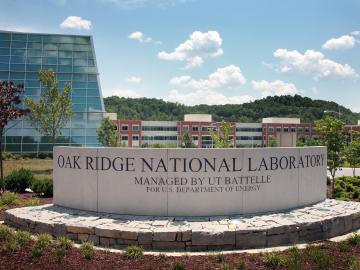
Filter News
Area of Research
- Advanced Manufacturing (8)
- Biology and Environment (29)
- Computational Engineering (1)
- Computer Science (2)
- Energy Science (56)
- Fusion and Fission (5)
- Isotope Development and Production (1)
- Isotopes (16)
- Materials (60)
- Materials Characterization (1)
- Materials for Computing (7)
- Materials Under Extremes (1)
- National Security (16)
- Neutron Science (21)
- Nuclear Science and Technology (5)
- Quantum information Science (1)
- Supercomputing (31)
News Type
News Topics
- (-) 3-D Printing/Advanced Manufacturing (61)
- (-) Biomedical (30)
- (-) Clean Water (9)
- (-) Cybersecurity (23)
- (-) Frontier (19)
- (-) Hydropower (2)
- (-) Isotopes (33)
- (-) Materials Science (71)
- (-) Mercury (6)
- Advanced Reactors (14)
- Artificial Intelligence (44)
- Big Data (20)
- Bioenergy (48)
- Biology (53)
- Biotechnology (17)
- Buildings (25)
- Chemical Sciences (44)
- Composites (15)
- Computer Science (77)
- Coronavirus (23)
- Critical Materials (13)
- Education (3)
- Element Discovery (1)
- Energy Storage (56)
- Environment (78)
- Exascale Computing (16)
- Fossil Energy (1)
- Fusion (26)
- Grid (23)
- High-Performance Computing (43)
- ITER (3)
- Machine Learning (23)
- Materials (69)
- Mathematics (5)
- Microelectronics (1)
- Microscopy (28)
- Molten Salt (3)
- Nanotechnology (35)
- National Security (35)
- Neutron Science (64)
- Nuclear Energy (44)
- Partnerships (33)
- Physics (42)
- Polymers (18)
- Quantum Computing (14)
- Quantum Science (36)
- Security (19)
- Simulation (18)
- Space Exploration (3)
- Statistics (1)
- Summit (24)
- Transportation (38)
Media Contacts

Scientists have uncovered the properties of a rare earth element that was first discovered 80 years ago at the very same laboratory, opening a new pathway for the exploration of elements critical in modern technology, from medicine to space travel.

Canan Karakaya, a R&D Staff member in the Chemical Process Scale-Up group at ORNL, was inspired to become a chemical engineer after she experienced a magical transformation that turned ammonia gas into ammonium nitrate, turning a liquid into white flakes gently floating through the air.

Two different teams that included Oak Ridge National Laboratory employees were honored Feb. 20 with Secretary’s Honor Achievement Awards from the Department of Energy. This is DOE's highest form of employee recognition.

Louise Stevenson uses her expertise as an environmental toxicologist to evaluate the effects of stressors such as chemicals and other contaminants on aquatic systems.

Corning uses neutron scattering to study the stability of different types of glass. Recently, researchers for the company have found that understanding the stability of the rings of atoms in glass materials can help predict the performance of glass products.



Four researchers at the Department of Energy’s Oak Ridge National Laboratory have been named ORNL Corporate Fellows in recognition of significant career accomplishments and continued leadership in their scientific fields.

Four scientists affiliated with ORNL were named Battelle Distinguished Inventors during the lab’s annual Innovation Awards on Dec. 1 in recognition of being granted 14 or more United States patents.

Guided by machine learning, chemists at ORNL designed a record-setting carbonaceous supercapacitor material that stores four times more energy than the best commercial material.


